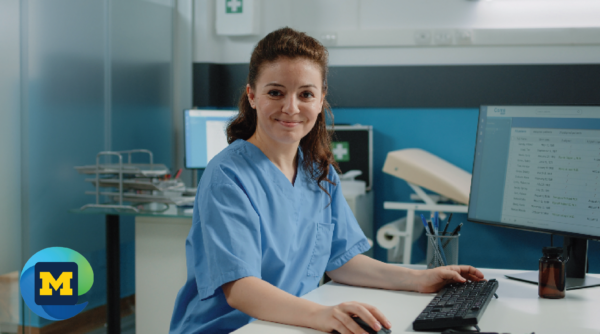
Kiosk computers are important and convenient hubs for clinicians and care teams across the U-M Health System. Kiosks are in most patient care areas across our outpatient clinics and hospitals, allowing fast user switching, quick access to MiChart, and other patient care resources. However, these secure, shared workstations require multiple logins with UMICH credentials throughout a shift, disrupting workflows and contributing to login fatigue.
To address this challenge, HITS introduced a new Edge UMICH browser, designed to streamline access and reduce login burdens. The Edge UMICH browser is a customized version of the Microsoft Edge browser, which launches with SharePoint and automatically logs the user into their Microsoft account and other key applications, as they are opened. Before launching system-wide, the HITS Customer Experience (CX) team took an essential step: engaging directly with frontline users to understand their needs and ensure a seamless experience.
Listening to users is research in action.
The UX team visited five different Michigan Medicine locations, including two inpatient floors and three outpatient clinics, to observe workflows and interview clinicians. In total, they spoke with more than 30 employees – including nurses, providers, and other care team members. This provided valuable feedback from actual Kiosk experiences.
What was discovered?
Automatic sign-in to the Clinical Home Page on SharePoint was well-received. The Clinical Home Page is a Michigan Medicine resource hub for clinicians as they are providing patient care. Users appreciated that it worked seamlessly without the hassle of extra logins.
Navigation improvements on SharePoint were helpful, with single sign-on links at the top of the Clinical Home Page, providing a smooth experience to access frequent resources like Outlook email, PolicyStat, and scheduling sites. Additional benefits of SharePoint navigation were also realized, with faster access to departmental websites on SharePoint, the ability to favorite/follow specific sites and improved search functionality.
Adjustments were needed. Users requested changes such as rearranging shortcut buttons and adding direct links to key apps like Microsoft Teams and Wolverine Access.
With feedback in hand, the team translated the insights into a tangible and better experience. Because of this attention:
- A pilot program was launched with one unit before the full rollout to ensure everything worked smoothly.
- An authenticated Microsoft Outlook desktop shortcut was added for easier email access.
- Button layouts were adjusted to better match user workflows.
- Efforts to enable passthrough authentication for other applications, including RL6, the patient safety reporting app, and Qgenda, a provider scheduling app, were prioritized.
This research-driven approach put the care teams first, providing a more efficient and less frustrating experience. By reducing login fatigue, the clinical staff are able to provide more focused care for their patients. The UX research also highlighted other needs that the Edge UMICH browser could not fulfill, like direct access to certain applications from MiChart. Our work continues to problem solve and meet those needs.
When engaging users directly in technical solutions, the tools become better and more effective. HITS has received positive feedback and few reported issues with the rollout of the Edge UMICH browser, helping to deem it a successful solution. HITS’ commitment to UX research and continuous improvement ensures that technology works for its people and not the other way around.
